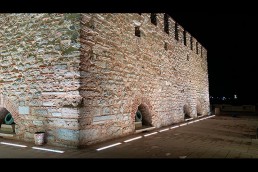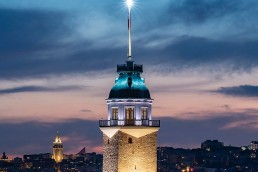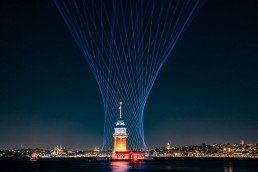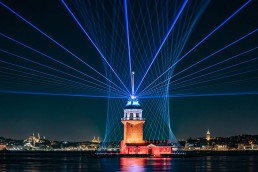This website uses cookies so that we can provide you with the best user experience possible. Cookie information is stored in your browser and performs functions such as recognising you when you return to our website and helping our team to understand which sections of the website you find most interesting and useful.
Maidens Tower
ProjectMaidens TowerLocationIstanbul, TurkeyManufacturersVariousLighting DesignerMKLD Lighting Design and Consulting, GermanyInstallerAstel, TurkeySubmitted byMKLD Lighting Design and Consulting
The focus of many legends, Istanbul’s Maidens Tower is an iconic and important building for the city’s residents, with a long history dating back to the Byzantine period. It is not only a major landmark and tourist attraction, but the tales and stories surrounding its history are firmly ingrained in the culture of Istanbul.
Going back many hundred years, this history is told and stunningly visualised. The captivating story of the tower was written by one of the most famous Turkish writers, Ayse Kulin. Translated into English and Arabic, it was the spoken by well-known actors. Special music was commissioned and produced by the designer to go along with the story.
This is not just an “attraction” – it is a project that is educational, fun to watch from near and far, whilst respecting the historical site and still using cutting edge technology.
The installed technology can of course also be used to program and execute different shows in the future. As part of the project, we created a very accurate 3D model with all the lights being able to be visualised and programmed off-line, this does not even require someone to be on-site. We successfully created a special show for the 100th anniversary of the foundation of Turkey, with lights and laser programmed off-site in Germany and then transferred to the show server on site.
As the principal designer – from the initial concept to equipment choice, music, visuals and programming – my idea was to weave the tales surrounding the building into a luminous narrative, akin to a theatrical performance.
The 8-minute show tells the history, tales and stories of the famous Maidens Tower, scripted by Turkish writer Ayse Kulin. As the installation is in the middle of the Bosporus, and the story of the tower is told in three languages, the task was to find a solution to send audio to visitors near and far, and giving them the opportunity to choose their language.
For distributing the audio through a web application, the designer chose French company Odiho For distributing the audio through a web application, Kuhn selected French company Odiho, which offered a turnkey solution with a low – and most importantly – constant delay of around 20ms, which could then be offset via timecode to sync lighting and audio. QR codes at selected areas link to the dedicated website for visitors to hear the work.
For the visitors along the seafront on the Üsküdar side of Istanbul, stationary RCF speakers on poles were deployed. Only the music accompanying the show is played here.
The foundation of the show is an architectural lighting system that encompasses the whole island and the tower. A mixture of inground and surface mounted RGBW fixtures are used. All are DMX controlled. During the captivating 8-minute performance, they come alive dynamically, orchestrating an array of colour and intensity transitions that set the stage for the visual narrative.
As the tower is situated in the middle of the Bosporus, and some of the lighting is barely 1m above sea level, all fixtures had to be rated not only to IP66 or better, but also certified to withstand harsh environment (ISO 12944 – C5).
The designers final choice came to SGM for their P2 and P6 POI flood lights, Anolis for their Eminere linear in-ground and Calumna spot fixtures, and Meyer Lighting for their in-ground uplights.
To add more drama and to make the show visible to spectators further away on the shores of the Bosporus, 48 laser source automated moving lights are deployed in the outer sea walls. These fixtures, which are normally used in concerts, were upgraded to meet the stringent harsh environment specifications of the project. They offer all the options normally used in show lighting and their beams can be seen from far away.
Together, the lighting system offers a multitude of options for the 8-minute show. Show control is from a MA3 replay unit, and was programmed offsite with an MA3 and a Depence R3.
To complement the lighting system, various lasers were added to the overall package. As video projection on the outer walls were deemed impractical due to the viewing distances of the audience, we decided to use laser projection instead.
This solution offers very high brightness and visibility, whilst still rendering enough detailing for the visuals. As the closest shoreline is at a distance of about 250m, the imagery is deliberately quite abstract and bold, so lasers are a perfect solution. 6 lasers are incorporated into the outer sea walls in 3 pairs), whilst one is inside the courtyard to project onto the tower itself. An 8th laser is mounted on a hydraulic platform that is raised before the show to shoot over the lower wooden annex on to the southern side of the tower.
The lasers are housed in specially built watertight enclosures and force-cooled.
All 8 Lasers are 22 Watt RGB units by RTI Sollinger.
On top of the aforementioned projection lasers, more lasers are used for aerial effects over the Bosporus, to make sure the show is visible from far away. 8x 55-Watt units are mounted on the top platform or the tower in a 360° setup.
Another 65 Watt Laser is pointing towards the Galata Tower in the central part of Istanbul, as part of the story talks about the historical connections between both towers. This is then complemented by yet another 65W Laser on the Galata Tower, shooting towards the Maidens Tower, from a distance of over 2km
Again, all lasers and control are by RTI Sollinger
The Maidens Tower is a listed historic monument, arguably the most important of its kind in Istanbul. The tower attracts a lot of daytime visitors, arriving by special boat shuttle, hence the main challenge was to hide all the equipment as much as possible from the daytime visitors.
As the lighting installation was part of a broader and thorough renovation of the tower, extensive consultations took place with the architects and the building commission for historical sites to ensure that in the daytime, the installation was as invisible as possible.
Whilst in-ground lighting was no issue, the main concern were the moving lights. In the end, a decision was made to incorporate them in the outer sea wall protecting the low-lying island from the splashing water. The sea wall was specifically designed with 48 cubicles facing the sea to house the moving lights. During the day, those cubicles are closed with a special cover, rendering the installation almost imperceptible. After the daytime visitors leave, the lights are uncovered. To blend them even more into the environment – even in the evening – the fixtures were commissioned in a special RAL tone matching the concrete walls.
The housings for the projection lasers were similarly built into these sea walls, with only a small window giving its purpose away. In between all the technology, there was still enough space for comfortable benches seating the visitors. This rendered a clean look to the overall daytime appearance.








